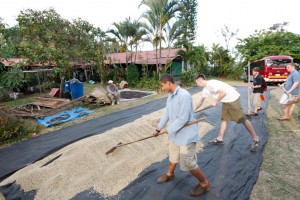Click for photos of San Isidro coffee farm: San Isidro coffee farm
See a video of our visit
“En armonía con su salud y la Naturaleza”
Yesterday we had a special treat. As part of our focus on land use and agriculture, we visited an organic coffee farm about 15 minutes by bus from the center of Atenas. The title above is the motto printed on the coffee bean bags “In harmony with your health and with nature.” The Spanish school director, spoke with several host families last night who shared with her how the students returned afterwards with opened eyes and full of stories from the tour.
This organic coffee farm is cared for by an association of eight families. I say “cared for” versus run or managed or owned because the approach the families use is one of tending to their own health and well-being along with the land.
About 16 years ago, this group of families made a conscious choice to separate from being part of a larger conventional coffee plantation and distinguish their coffee farm by using organic practices. While the yield of coffee is about 50% less, compared to conventional intensive practices, they balance this with being able to charge a bit more for the beans and receive the benefit of supporting their own communities’ health and long-term viability of their land.
Gabriel, our guide and an eloquent, humble and vibrantly enthusiastic farmer welcomed us to learn about how they have incorporated more and more permaculture practices through the years– designing their farm and home by modeling the relationships found in natural ecologies. Gabriel’s father one of the key people who started the farm, shared how he has noticed feeling significantly better after being quite ill when he was working on the conventional farm.
The majority of coffee growers become caught in a cycle of high inputs, adding synthetic fertilizer, herbicides and pesticides and a lot of water. Gabriel explained the perpetuating cycle something like this:
The desire make a fast profit, pushes farmers to have crops produce as much as possible. So a sun tolerant coffee plant is developed and farmers add fertilizer to increase the yield. This then encourages more growth of other weedy plants, which are seen as robbing water and nutrients from the coffee bushes. So herbicides are applied. Now, the insects, which were munching on some of the other nearby plants, must concentrate on the coffee plants, so pesticides are added. The ground around the plants is now barren. So when the tropical rains come, the water washes down the dry hillsides leaching out more nutrients and carrying with it these additives as well as soil into the rivers. So the farmers may need to add more irrigation and more fertilizer. And on top of this the exposure to the chemicals affects the daily health of people who work on the farms and rely on the water for living. Phew!
Gabriel shared how the key to permaculture farming is in the details. On the farm everything has a place and purpose. Over 100 different trees species, many of which produce edible crops like platano, banana, papaya, guayaba, poro, and vanilla help create a dappled shade over the coffee bushes. These crops are used to feed the families and the families work to manage the canopy to make sure just the right amount of light comes through for optimal coffee harvest. Gabriel and the other farmers worked with the topography of the land by digging little holding areas for the water with rocks and a type of plant called caño to allow the water to seep into the ground instead of running off the steep slopes. Leaves are allowed to fall from the plants and decompose naturally on the ground – this leaf cover creates a kind of mulch that maintains the moisture and keeps down the growth of too many weeds, although some smaller green plants are allowed to grow and their roots help maintain the soil. Dehydrated chicken waste fertilizer from a nearby farm is added at the base of the coffee bushes to bring in extra nutrients. All the coffee bean shells removed during processing are composted and then added back to the land. These are just some of the details we saw.
The way the coffee is processed is also unique. The family association purchased special machinery developed in Colombia which removes the coating and sticky pulp of the fresh coffee fruits using a less than 1% of the water used in a conventional processor. Check out the video to see it in action!
I am inspired by the depth of purpose that Gabriel, his father and the other families bring to their livelihood. The farm meets the highest international organic standards and beyond. Being an organic farmer in Costa Rica these days is not easy. The farmers must take on the financial risk and extra work of converting the farm to meet the organic standards and pay for the certification — the Costa Rican government does not support this financially. Despite the image of Costa Rica as supporting good environmental practices, in the last several years the numbers of organic farms has declined. The higher price that organic coffee gets on the market is not enough of an incentive. It takes farmers who see themselves participating in a bigger ecological picture and commitment to overall well-being. And as Gabriel encouraged, it takes consumers who care and actively choose to support people and food streams that encourage biodiversity and health along the whole web of interconnections.
We thoroughly enjoyed our visit and left with the delightful taste of freshly brewed coffee and cookies, several bags of organic beans to bring home and a new perspective. Thank you, Juan, for organizing such a great opportunity!

